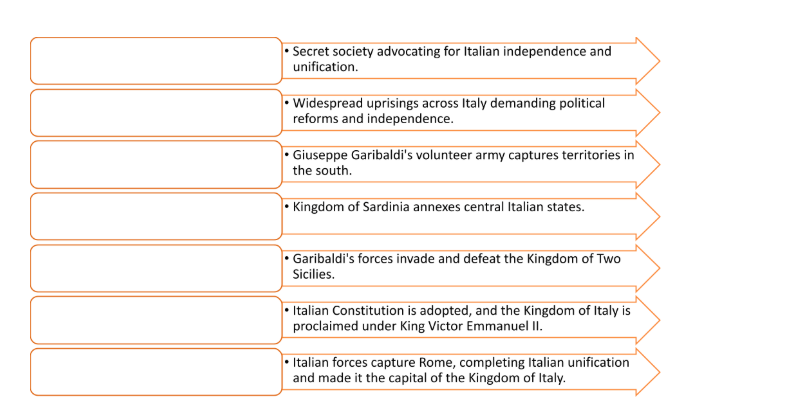Unification of Italy
Published on 05 Oct 2025
Italy's unification, known as the Risorgimento, was a political and social movement that led to the consolidation of various Italian states into the Kingdom of Italy in 1861. It was driven by nationalist sentiments, influential figures like Giuseppe Garibaldi, and military conflicts, ultimately resulting in the establishment of a unified Italian nation.
Important Events of Italian Unification

Factors that led to Italian Unification
Historical Consciousness: The Italian region had a historical consciousness of unity dating back to the Roman Empire and the Renaissance, which fostered a sense of common identity among Italians.
Role of Napoleon Bonaparte: Napoleon's capture of Italy and introduction of new institutions instilled a sense of unity in the region, while also sparking Italian nationalism.
Example: Napoleon's reforms in the Kingdom of Italy laid the groundwork for administrative and legal unity.
Role of the Vienna Congress: The Vienna Congress deliberately divided Italy, considering it merely a geographical expression rather than a unified nation.
Example: The division of Lombardy and Venetia under Austrian control, placing Parma, Modena, and Tuscany under Habsburg rule, and assigning Naples and Sicily to the Bourbon kings.
Role of 1848 Revolts: It challenged Austrian control and established a liberal government but failed to gain independence from Austria.
Impact of Italian Unification
Economic Impact:
Industrial Centres: The northern industrial cities of Milan and Turin experienced significant growth, becoming hubs of manufacturing and commerce.
Agricultural Reforms: Land reforms and irrigation projects improved agricultural productivity, benefiting rural communities.
Economic Integration: The creation of a unified market and transportation infrastructure facilitated trade and economic cooperation across Italy.
Cultural Renaissance:
Promotion of Italian Identity: It fostered a sense of national identity and pride, promoting the use of the Italian language and celebrating Italian history and culture.
Example: Giuseppe Verdi and Alessandro Manzoni made significant contributions to literature and the arts.
Social Reforms:
Workers' Rights: Labour movements gained momentum, leading to the establishment of workers' rights and the improvement of working conditions.
Healthcare: Efforts were made to improve public health, including the establishment of hospitals and the expansion of healthcare services.
Poverty Alleviation: Social welfare initiatives aimed at reducing poverty and aiding the less fortunate.
Global Impact:
Influence on European Politics: Italian unification challenged the dominance of existing European powers and inspired nationalist movements seeking independence, such as those in Germany and other parts of Europe.